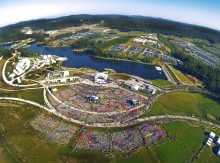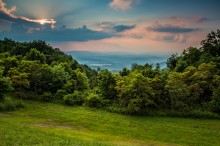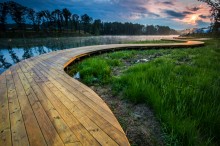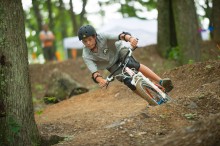(Story by Rick Steelhammer, Charleston Gazette. Photos courtesy of the Boy Scouts of America.)

Summit Stadium, which can seat 80,000 people.
The Boy Scout, the Sunday Gazette-Mail West Virginian of the Year for 2014, has been a presence in the state for nearly 100 years, but has never been more visible, energetic and powerful here than he is today.
Since 1916, when the state’s first councils of Boy Scouts of America were chartered in Clarksburg and Wheeling, generations of West Virginia boys in every corner of the state have learned leadership, citizenship, community service and self-reliance skills from peer and adult leaders and bonded with friends on outings, hikes, camp-outs and summer camp sessions.
While scouting has long been a part of the background in the tableau of West Virginia life, Boy Scouts moved to the forefront of public attention here after 2007, when the BSA’s national headquarters began a nationwide search for a new home for the national Scout jamboree, a gathering held every four years drawing tens of thousands of youth members and adult volunteers.
 After an 18-month search, during which members of a site selection committee visited more than 80 locations in 28 states, a 10,600-acre tract of land adjacent to Garden Ground Mountain in the New River Gorge was chosen. By then, plans for the property had morphed to include the development not only of a jamboree site, but a national leadership center, as well as the site of the BSA’s fourth high adventure base, complementing the existing Philmont Scout Ranch in New Mexico, the Northern Tier High Adventure Base in Minnesota, and the Florida Sea Base.
After an 18-month search, during which members of a site selection committee visited more than 80 locations in 28 states, a 10,600-acre tract of land adjacent to Garden Ground Mountain in the New River Gorge was chosen. By then, plans for the property had morphed to include the development not only of a jamboree site, but a national leadership center, as well as the site of the BSA’s fourth high adventure base, complementing the existing Philmont Scout Ranch in New Mexico, the Northern Tier High Adventure Base in Minnesota, and the Florida Sea Base.
The Garden Ground Mountain site, which borders 13 miles of the National Park Service’s New River Gorge National River, was officially selected as BSA’s National Scout Jamboree/High Adventure Program site in November 2009.
Generous gifts from wealthy Boy Scout alumni paid for the property and got construction underway. Engineering executive Stephen D. Bechtel Jr. came through with the biggest single contribution ever made to the BSA — $50 million — while businessman-philanthropist and Eagle Scout Walter Scott Jr. and The Greenbrier owner Jim Justice each donated $25 million. Other major donors included Consol Energy, with a gift of $15 million, the J.W. and Hazel Ruby Foundation of Morgantown, $10 million, and Pennsylvania trucking magnate Ed Arnold and his wife, Jeanne, who also donated $10 million.
 With only about three years left to convert a 16-square-mile tract of undeveloped woodland and former surface mining land into the Summit Bechtel Family National Scout Reserve in time for the 2013 National Scout Jamboree, the national BSA organization, in cooperation with state, federal and county officials, hit the ground running.
With only about three years left to convert a 16-square-mile tract of undeveloped woodland and former surface mining land into the Summit Bechtel Family National Scout Reserve in time for the 2013 National Scout Jamboree, the national BSA organization, in cooperation with state, federal and county officials, hit the ground running.
The state Department of Environmental Protection committed more than $10 million in abandoned mine lands reclamation funds to backfill and regrade some of the 15 miles of old highwalls, some dating back to the 1940s, left on the land. Some of the reclamation-associated earthmoving activity was incorporated into the BSA’s construction plans for access roads and the development of camping and recreation areas.
Construction at the site kept an average of nearly 850 workers on the job from 2010 to 2013, and pumped nearly $170 million into the Southern West Virginia economy.
Pains were taken to make the Summit sustainable. First and foremost, 90 percent of the Summit’s 10,600 acres has been protected from development and will be left as is, including a 1,600-acre tract of creeks and wetlands bordering National Park Service land that is protected by a conservation easement.
Gray water from sinks and showers is reused to flush toilets, dramatically reducing water intake and wastewater treatment costs. Timber harvested on the site and milled locally was used to build the Summit’s showerhouses.
“We’re trying to keep our footprint as small as possible, and we’re trying to limit it to areas that have already been disturbed by mining and timbering,”said Allison Schapker, director of design and sustainability for Trinity Works, the Summit’s design firm.
 Designers were brought in from around the world to build state-of-the-art BMX bike courses and skateboard courts, 125 climbing walls, 100 bouldering stations, 45 rappelling venues, 36 miles of mountain bike trails, five miles of zipline challenge courses, 13 acres of shooting sports ranges, and facilities for kayaking, stand-up paddleboarding and other activities.
Designers were brought in from around the world to build state-of-the-art BMX bike courses and skateboard courts, 125 climbing walls, 100 bouldering stations, 45 rappelling venues, 36 miles of mountain bike trails, five miles of zipline challenge courses, 13 acres of shooting sports ranges, and facilities for kayaking, stand-up paddleboarding and other activities.
Slightly more than 30,000 scouts and scout leaders took part in the 2013 National Scout Jamboree. All scouts spent part of their Jamboree time working on community service projects across Southern West Virginia, ranging from trail building to helping archaeologists excavate the grounds of an 18th-century frontier fort. All totaled, the scouts donated 148,000 hours to public service projects.
This summer, the Summit debuted its high adventure program, which involved 3,610 scouts and four weeklong activity themes: the River, focusing on whitewater kayaking and rafting; the Marksman, targeting a wide variety of shooting and archery sports; the Wheels, featuring mountain biking challenges; and the Summit Experience, a sampling of a variety of Summit activities. Also launched in 2014 was a Mountaineer Weekend program, which gave 448 scouts a condensed version of a high-adventure week.
Once again, participating scouts donated 17,000 hours to volunteer work at the Summit or in the adjoining New River Gorge National River.
The Summit will host the next National Scout Jamboree in 2017 as well as the 2019 World Scout Jamboree.
Last month, West Virginia voters overwhelmingly approved the first constitutional amendment put up for consideration in the past 10 years, allowing the Boy Scouts to retain their tax-exempt status in leasing venues at the Summit — like its 80,000 seat amphitheater for concerts, or its BMX or mountain bike courses for races — to for-profit concerns, subject to legislative restrictions. The move makes it possible to bring more tourism-enhancing events to the area, while giving the Summit another revenue stream to help pay for new programs and upkeep.
“The Boy Scouts of America is very thankful to the citizens of West Virginia for passing this amendment,” said Gary Hartley, community and government relations director for the Summit Bechtel Reserve. “When we chose this site for the Summit, we also believed that it was a great opportunity to expose other parts of the world to this extraordinary state, and we can continue to do so on an even larger scale through the passing of this amendment.”
Click here to read more…

